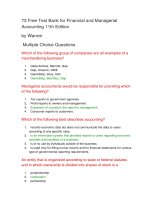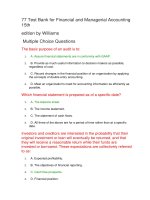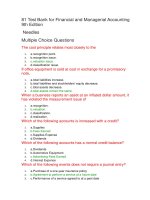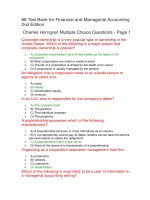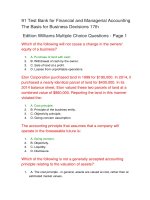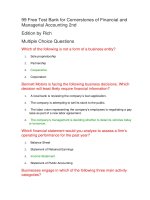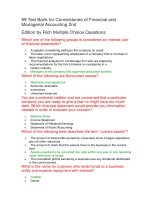126 test bank for financial and managerial accounting information for decisions 4th
Bạn đang xem bản rút gọn của tài liệu. Xem và tải ngay bản đầy đủ của tài liệu tại đây (73.44 KB, 25 trang )
126 Test Bank for Financial and Managerial Accounting
Information for Decisions 4th
Multiple Choice Questions-Page 1
Social responsibility:
1.
2.
3.
4.
5.
A. Is a concern for the impact of one's actions on society as a whole
B. Is a code that helps in dealing with confidential information
C. Is required by the SEC
D. Requires that all businesses conduct social audits
E. Is mandated by the federal government
Which of the following is the correct sequence for the heading for
ABC Company's 2010 Balance Sheet?
1.
2.
3.
4.
5.
A. ABC Company, For the year ended 12/31/10, Balance Sheet
B. For the year ended 12/31/10, Balance Sheet, ABC Company
C. Balance Sheet, 12/31/10, ABC Company
D. 12/31/10, ABC Company, Balance Sheet
E. ABC Company, Balance Sheet, 12/31/10
To include the personal assets and transactions of a business's
owner in the records and reports of the business would be in
conflict with the:
1.
2.
3.
4.
5.
A. Objectivity principle
B. Realization principle
C. Business entity principle
D. Going-concern principle
E. Revenue recognition principle
The objectivity principle:
1.
2.
3.
4.
5.
A. Means that information is supported by independent, unbiased evidence
B. Means that information can be based on what the preparer thinks is true
C. Means that financial statement should contain information that is optimistic
D. Means that a business may not recognize revenue until cash is received
E. Means the assets acquired must be recorded and what the company paid
for them
The accounting principle that requires accounting information to be
based on actual cost and requires assets and services to be
recorded initially at the amount of cash or cash-equivalent given in
exchange is the:
1.
2.
A. Accounting equation
B. Cost principle
3.
4.
5.
C. Going-concern principle
D. Realization principle
E. Business entity principle
Generally Accepted Accounting Principles:
1.
2.
3.
4.
A. Focus on the review of a situation
B. Does not require financial statements
C. Never change
D. Intend to make information on the financial statements relevant, reliable
and comparable
5. E. Oversees Security and Exchange Commission
Which of the following elements are found on the Balance Sheet?
1.
2.
3.
4.
5.
A. Service Revenue
B. Net Income
C. Operating Activities
D. Utilities Expense
E. Retained Earnings
A corporation:
1.
2.
3.
4.
5.
A. Is a legal entity separate and distinct from its owners
B. Must have many owners
C. Has shareholders who have unlimited liability for the acts of the corporation
D. Is the same as a limited liability partnership
E. Does not have to pay taxes
Which of the following is the primary purpose of accounting?
1.
2.
3.
4.
5.
A. To establish a business
B. To identify, record and communicate business transactions
C. To deceive stockholders
D. To keep from paying taxes
E. To establish credit for a company
Businesses can take all of the following forms except:
1.
2.
3.
4.
5.
A. Sole proprietorship
B. Common stock
C. Partnership
D. Corporation
E. Limited Liability Corporation
Internal users of accounting information include:
1.
2.
3.
4.
A. Shareholders
B. Customers
C. Creditors
D. Government regulators
5.
E. Line Supervisor
A parcel of land is: offered for sale at $150,000, assessed for tax
purposes at $95,000, recognized by its purchasers as being worth
$140,000 and purchased for $137,000. The land should be
recorded in the purchaser's books at:
1.
2.
3.
4.
5.
A. $95,000
B. $137,000
C. $138,500
D. $140,000
E. $150,000
The organization that attempts to create more harmony among the
accounting practices of different countries by identifying preferred
practices and encouraging their worldwide acceptance is the:
1.
2.
3.
4.
5.
A. AICPA
B. FASB
C. CAP
D. SEC
E. IASB
Technological advancement
1.
2.
3.
A. Has replaced accounting
B. Has not changed the work that accountants do
C. Has freed accounting professionals to concentrate more on the analysis
and interpretation of information
4. D. In accounting has replaced the need for decision makers
5. E. In accounting is only available to large corporations
The financing functions of a business include:
1.
2.
3.
4.
5.
A. Research and development
B. Purchasing
C. Marketing
D. Distribution
E. Selling common stock
Which of the following elements are found on the income
statement?
1.
2.
3.
4.
5.
A. Cash
B. Accounts Receivable
C. Common Stock
D. Retained Earnings
E. Salaries Expense
Which accounting assumption assumes that all accounting
information is reported monthly or yearly?
1.
2.
3.
4.
5.
A. Business entity assumption
B. Monetary unit assumption
C. Value assumption
D. Cost assumption
E. Time period assumption
Ethical behavior requires:
1.
2.
3.
4.
5.
A. That an auditors' pay not depend on the figures in the client's reports
B. Auditors to invest in businesses they audit
C. Analysts to report information favorable to their companies
D. Managers to use accounting information to benefit themselves
E. That an auditor provides a favorable opinion
Identifying business activities requires selecting transactions and
events relevant to an organization. Which of the following events
would be recorded in the accounting records of Acme Car Wash?
1.
2.
A. Acme washes 500 cars
B. J.B. Smith, a customer, buys lunch at the restaurant next door to Acme
while waiting for her car to be washed
3. C. Clean Company, a supplier, sells 50 pounds of soap to ABC Company
4. D. Sudsey Company, a supplier, goes out of business
5. E. Acme hires Andrea as a receptionist
The primary objective of financial accounting is:
1.
2.
A. To serve the decision-making needs of internal users
B. To provide financial statements to help external users analyze and interpret
an organization's activities
3. C. To monitor and control company activities
4. D. To provide information on both the costs and benefits of managing products
and services
5. E. To know what, when and how much to produce
Which of the following statements is true of external information
users?
1.
2.
3.
4.
A. They are directly involved in managing the organization
B. Their needs are met by the managerial area of accounting
C. They have limited access to an organization's accounting information
D. They use accounting information to help improve the efficiency and
effectiveness of an organization
5. E. They are the only users of accounting information who rely on internal
controls to monitor company activities
An Asset is:
1.
2.
3.
4.
5.
A. only acquired with cash
B. something the company owns
C. only contributed by stockholders
D. a company's obligation to pay
E. is also called contributed capital
The principle that (1) requires revenue to be recognized at the time
it is earned, (2) allows the inflow of assets associated with revenue
to be in a form other than cash and (3) measures the amount of
revenue as the cash plus the cash equivalent value of any non-cash
assets received from customers in exchange for goods or services
is called the:
1.
2.
3.
4.
5.
A. Going-concern principle
B. Cost principle
C. Revenue recognition principle
D. Objectivity principle
E. Business entity principle
The accounting guideline prescribing that financial statement
information be supported by independent, unbiased evidence other
than someone's belief or opinion is the:
1.
2.
3.
4.
5.
A. Business entity principle
B. Monetary unit principle
C. Going-concern principle
D. Cost principle
E. Objectivity principle
Internal users of accounting information always include:
1.
2.
3.
4.
5.
A. Shareholders
B. Managers
C. Lenders
D. Suppliers
E. Customers
The area of accounting aimed at serving the decision making needs
of internal users is:
1.
2.
3.
4.
5.
A. Financial accounting
B. Managerial accounting
C. External auditing
D. SEC reporting
E. Governmental accounting
Recording the items on the financial statements in dollars is:
1.
A. Objectivity principle
2.
3.
4.
5.
B. Monetary unit principle
C. Revenue recognition principle
D. Going-concern principle
E. Cost principle
The principle prescribing that financial statements reflect the
assumption that the business will continue operating instead of
being closed or sold, unless evidence shows that it will not continue
is the:
1.
2.
3.
4.
5.
A. Going-concern principle
B. Business entity principle
C. Objectivity principle
D. Cost Principle
E. Monetary unit principle
Which of the following statements best describes the relationship of
U.S. GAAP and IFRS?
1.
2.
3.
4.
5.
A. They are identical
B. They are entirely different conceptual frameworks
C. They are similar but not identical
D. Neither has anything to do with accounting
E. They both relate only to publicly traded companies
Which of the following accounting principles dictates when
expenses are recognized?
1.
2.
3.
4.
5.
A. Revenue recognition principle
B. Monetary unit principle
C. Business entity principle
D. Matching principle
E. Full disclosure principle
126 Free Test Bank for Financial and Managerial
Accounting Information for Decisions 4th Edition by Wild
Multiple Choice Questions-Page 2
An example of an operating activity is:
1.
2.
3.
4.
5.
A. Paying wages
B. Purchasing office equipment
C. Borrowing money from a bank
D. Selling stock
E. Paying off a loan
Decreases in retained earnings that represent costs of assets or
services that are used to earn revenues are called:
1.
2.
3.
4.
5.
A. Liabilities
B. Equity
C. Withdrawals
D. Expenses
E. Contributed Capital
An example of an investing activity is:
1.
2.
3.
4.
5.
A. Paying wages of employees
B. Paying dividends
C. Purchasing land
D. Selling inventory
E. Contribution from owner
The question of when revenue should be recognized on the income
statement (according to GAAP) is addressed by the:
1.
2.
3.
4.
5.
A. Revenue recognition principle
B. Going-concern principle
C. Objectivity principle
D. Business entity principle
E. Cost principle
Assets = Liabilities + Equity is known as the:
1.
2.
3.
4.
5.
A. Income statement equation
B. Cost principle
C. Objectivity principle
D. Accounting equation
E. Transaction principle
The International Accounting Standards Board (IASB)
1.
2.
A. Hopes to create harmony among accounting practices of different countries
B. Is the government group that establishes reporting requirements for
companies that issue stock to the public
3. C. Has the authority to impose its standards on companies
4. D. Is the only source of U.S. generally accepted accounting principles (GAAP)
5. E. Applies only to companies that are members of the European Union
On December 15, 2008, Myers Legal Services signed a $50,000
contract with a client to provide legal services to the client in 2009.
Which accounting principle would require Myers Legal Services to
record the legal fees revenue in 2009 and not 2008?
1.
2.
3.
4.
5.
A. Monetary unit principle
B. Going-concern principle
C. Cost principle
D. Business entity principle
E. Revenue recognition principle
An example of a financing activity is:
1.
2.
3.
4.
5.
A. Buying office supplies
B. Obtaining a long-term loan
C. Buying office equipment
D. Selling inventory
E. Buying land
Revenues are:
1.
2.
3.
4.
5.
A. The same as net income
B. The excess of expenses over assets
C. Resources owned or controlled by a company
D. Increases in retained earnings from a company's earning activities
E. The costs of assets or services used
The difference between a company's assets and its liabilities or its
net assets is:
1.
2.
3.
4.
5.
A. Net income
B. Expense
C. Equity
D. Revenue
E. Net loss
Increases in retained earnings from a company's earnings activities
are:
1.
2.
3.
4.
5.
A. Assets
B. Revenues
C. Liabilities
D. Stockholder's Equity
E. Expenses
The major activities of a business include:
1.
2.
3.
4.
5.
A. Operating, Investing, Making a Profit
B. Investing, Making a Profit, Operating
C. Making a Profit, Operating, Borrowing
D. Operating, Investing, Financing
E. Investing, Making a Profit, Financing
Net Income:
1.
2.
3.
4.
5.
A. Decreases equity
B. Represents the amount of assets owners put into a business
C. Equals assets minus liabilities
D. Is the excess of revenues over expenses
E. Represents the owners' claims against assets
Planning activities:
1.
2.
A. Are the means organizations must use to pay for resources
B. Involve the acquiring and disposing of resources that an organization uses
to acquire and sell its products or services
3. C. Involve defining the ideas, goals and actions of an organization
4. D. Are the carrying out of an organization's plans
5. E. Involve using resources to research, develop, purchase, produce and
market products and services
The description of the relation between a company's assets,
liabilities and equity, which is expressed as Assets = Liabilities +
Equity are known as the:
1.
2.
3.
4.
5.
A. Income statement equation
B. Accounting equation
C. Business equation
D. Return on equity ratio
E. Net income
Expenses:
1.
2.
3.
4.
5.
A. Increase retained earnings
B. Are increases in retained earnings from a company's earning activity
C. Are the costs of assets or services used to earn revenues
D. Occur when retained earnings exceed revenue
E. Are creditor's claims on assets
Marian Mosely is the owner of Mosely Accounting Services. Which
accounting principle requires Marian to keep her personal financial
information separate from the financial information of Mosely
Accounting Services?
1.
2.
3.
4.
5.
A. Monetary unit principle
B. Going-concern principle
C. Cost principle
D. Business entity principle
E. None of these. Since Marian is a sole proprietor, she is not required to
separate her personal financial information from the financial information of
Mosely Accounting Services
Which of the following accounting principles would prescribe that all
goods and services purchased is recorded at cost?
1.
2.
3.
4.
5.
A. Going-concern principle
B. Continuing-concern principle
C. Cost principle
D. Business entity principle
E. Consideration principle
If liabilities are $51,500 and assets are $173,425, then equity
equals:
1.
2.
3.
4.
5.
A. $224,925
B. $51,500
C. $173,425
D. $121,925
E. $103,000
The Maximum Experience Company acquired a building for
$500,000. Maximum Experience had an appraisal done and found
that the building was worth $575,000. The seller had paid $300,000
for the building 6 years ago. Which accounting principle would
prescribe that Maximum Experience record the building on its
records at $500,000?
1.
2.
3.
4.
5.
A. Monetary unit principle
B. Going-concern principle
C. Cost principle
D. Business entity principle
E. Revenue recognition principle
If equity is $300,000 and liabilities are $192,000, then assets equal:
1.
2.
3.
4.
5.
A. $108,000
B. $192,000
C. $300,000
D. $492,000
E. $792,000
Creditors' claims on the assets of a company are called:
1.
2.
3.
4.
5.
A. Net losses
B. Expenses
C. Revenues
D. Equity
E. Liabilities
The amounts reported in the accounts for assets used in operations
are based on their costs. This practice is best justified by the:
1.
2.
3.
4.
5.
A. Cost principle
B. Going-concern principle
C. Objectivity principle
D. Business entity principle
E. Revenue recognition principle
Revenue is properly recognized:
1.
2.
3.
4.
A. When the customer's order is received
B. Only if the transaction creates an account receivable
C. At the end of the accounting period
D. Upon completion of the sale or when services have been performed and
the business obtains the right to collect the sale price
5. E. When cash from a sale is received
Resources owned or controlled by a company that are expected to
yield benefits are:
1.
2.
3.
4.
5.
A. Assets
B. Revenues
C. Liabilities
D. Stockholder's Equity
E. Expenses
According to generally accepted accounting principles, a company's
balance sheet should show the company's assets at:
1.
2.
3.
A. The cash equivalent value of what was given up
B. The current market value of the assets at the balance sheet date
C. The cash paid to acquire them, even if something other than cash was
given in the exchange
4. D. The best estimate from a certified internal auditor
5. E. The objective value to external users
Congress passed the Sarbanes-Oxley Act to
1.
2.
3.
4.
5.
A. Provide jobs to U.S. accountants and limit the number of jobs sent outside
the country
B. Impose penalties on CEO's and CFO's who knowingly sign off on bogus
accounting reports, although at this time the penalties are token amounts
C. Help curb financial abuses at companies that issue their stock to the public
D. Force auditors to attest to the absolute accuracy of the financial statements
E. Require that all companies publicly disclose their internal control plans
A limited partnership:
1.
2.
3.
4.
5.
A. Includes a general partner with unlimited liability
B. Is subject to double taxation
C. Has owners called stockholders
D. Is the same as a corporation
E. Must only have two partners
Operating activities:
1.
A. Are the means organizations must use to pay for resources like land,
buildings and equipment
2. B. Involve using resources to research, develop, purchase, produce, distribute
and market products and services
3.
C. Involve acquiring and disposing of resources that a business uses to
acquire and sell its products or services
4. D. Are also called asset management
5. E. Are also called strategic management
Net income:
1.
2.
3.
4.
5.
A. Occurs when revenues exceed expenses
B. Is the same as revenue
C. Equals resources owned or controlled by a company
D. Occurs when expenses exceed assets
E. Represents assets taken from a company for an owner's personal use
126 Free Test Bank for Financial and Managerial
Accounting Information for Decisions 4th Edition by Wild
Multiple Choice Questions-Page 3
If assets are $365,000 and equity is $120,000, then liabilities are:
1.
2.
3.
4.
5.
A. $120,000
B. $245,000
C. $365,000
D. $485,000
E. $610,000
An exchange of value between two entities is called:
1.
2.
3.
4.
5.
A. The accounting equation
B. Recordkeeping or bookkeeping
C. A business transaction
D. An asset
E. Net Income
Compute return on assets given net income of $13,764, beginning
assets of $120,000 and ending assets of $176,000.
1.
2.
3.
4.
5.
A. 4.65%
B. 7.82%
C. 9.3%
D. 11.47%
E. 21.51%
Fast-Forward has net income of $18,955 and assets at the
beginning of the year of $200,000. Its assets at the end of the year
total $246,000. Compute its return on assets.
1.
2.
3.
A. 7.7%
B. 8.5%
C. 9.5%
4.
5.
D. 11.8%
E. 13.0%
U.S. government bonds are:
1.
2.
3.
4.
5.
A. High-risk and high-return investments
B. Low-risk and low-return investments
C. High-risk and low-return investments
D. Low-risk and high-return investments
E. High risk and no-return investments
Beta Corporation purchased $100,000 worth of land by paying
10,000 cash and signing a $90,000 mortgage. Immediately prior to
this transaction the corporation had assets, liabilities and owners'
equity in the amounts of $150,000; $30,000; and $120,000
respectively. What is the total amount of Beta Corporation's assets
after this transaction has been recorded?
1.
2.
3.
4.
5.
A. $240,000
B. $250,000
C. $160,000
D. $40,000
E. $260,000
A corporation purchased a $40,000 delivery truck by paying 4,000
cash and signing a $36,000 note payable. Immediately prior to this
transaction the corporation had assets, liabilities and owners' equity
in the amounts of $75,000; $52,000; and $23,000 respectively.
What is the total amount of the corporation's assets after this
transaction has been recorded?
1.
2.
3.
4.
5.
A. $115,000
B. $111,000
C. $79,000
D. $71,000
E. $75,000
If the assets of a business increased $15,000 during a period of
time and its equity decreased $46,000 during the same period,
liabilities in the business must have:
1.
2.
3.
4.
5.
A. Increased $11,000
B. Decreased $11,000
C. Increased $19,000
D. Decreased $19,000
E. Increased $61,000
The excess of expenses over revenues for a period is:
1.
2.
3.
4.
5.
A. Net assets
B. Equity
C. Net loss
D. Net income
E. A liability
Our company has three times as many assets as it does liabilities. If
total liabilities are $55,000, what is the amount of owners' equity?
1.
2.
3.
4.
5.
A. $55,000
B. $110,000
C. $165,000
D. $220,000
E. Cannot be determined from the given information
Which of the following statements is not true about assets?
1.
2.
3.
4.
5.
A. They are economic resources owned or controlled by the business
B. They are expected to provide future benefits to the business
C. They appear on the balance sheet
D. They appear on the statement of retained earnings
E. Claims on them are shared between creditors and owners
If the assets of a business increased $89,000 during a period of
time and its liabilities increased $67,000 during the same period,
equity in the business must have:
1.
2.
3.
4.
5.
A. Increased $22,000
B. Decreased $22,000
C. Increased $89,000
D. Decreased $156,000
E. Increased $156,000
Risk is:
1.
2.
3.
A. Net income divided by average total assets
B. The reward for investment
C. The uncertainty about the expected return that will be earned from an
investment
4. D. Unrelated to expected return
5. E. Derived from the idea of getting something back from an investment
The balance sheet equation is:
1.
2.
3.
4.
5.
A. Revenues minus expenses equal net income
B. Debits equal credits
C. The bookkeeping phase of accounting
D. Another name for the accounting equation
E. Assets minus liabilities and equity
Photometer Company paid off $30,000 of its accounts payable in
cash. What would be the effects of this transaction on the
accounting equation?
1.
2.
3.
4.
5.
A. Assets, $30,000 increase; liabilities, no effect; equity, $30,000 increase
B. Assets, $30,000 decrease; liabilities, $30,000 decrease; equity, no effect
C. Assets, $30,000 decrease; liabilities, $30,000 increase; equity, no effect
D. Assets, no effect; liabilities, $30,000 decrease; equity, $30,000 increase
E. Assets, $30,000 decrease; liabilities, no effect; equity $30,000 decrease
Distributions of assets by a business to its stockholders are called:
1.
2.
3.
4.
5.
A. Dividends
B. Expenses
C. Assets
D. Retained earnings
E. Net Income
Another name for equity is:
1.
2.
3.
4.
5.
A. Net income
B. Expenses
C. Net assets
D. Revenue
E. Net loss
Consider the risk of the following investments. Choose the answer
that lists the investments in order from highest expected return to
lowest expected return.
1.
2.
3.
4.
5.
A. Drilling exploration to discover oil, stock in a secure "blue chip" corporation,
government bonds
B. Stock in a secure "blue chip" corporation, government bonds, drilling
exploration to discover oil
C. Government bonds, drilling exploration to discover oil, stock in a secure
"blue chip" corporation
D. Drilling exploration to discover oil, government bonds, stock in a secure
"blue chip" corporation
E. Government bonds, stock in a secure "blue chip" corporation, drilling
exploration to discover oil
If the liabilities of a business increased $75,000 during a period of
time and the equity in the business decreased $30,000 during the
same period, the assets of the business must have:
1.
2.
3.
4.
A. Decreased $105,000
B. Decreased $45,000
C. Increased $30,000
D. Increased $45,000
5.
E. Increased $105,000
If assets are $99,000 and liabilities are $32,000, then equity
equals:
1.
2.
3.
4.
5.
A. $32,000
B. $67,000
C. $99,000
D. $131,000
E. $198,000
Assets created by selling goods and services on credit are:
1.
2.
3.
4.
5.
A. Accounts payable
B. Accounts receivable
C. Liabilities
D. Expenses
E. Equity
The assets of a company total $700,000; the liabilities, $200,000.
What are the total claims of the owners?
1.
2.
3.
4.
5.
A. $900,000
B. $700,000
C. $500,000
D. $200,000
E. It is impossible to determine unless the amount of owners' investment is
known
Return on assets is:
1.
2.
A. Also called rate of return
B. Computed by dividing net income by beginning assets plus ending assets
divided by two
3. C. Computed by multiplying net income by total assets
4. D. Used in helping evaluate expenses
5. E. Found on the balance sheet
How would the accounting equation of Boston Company be affected
by the billing of a client for $10,000 of consulting work completed?
1.
2.
3.
4.
5.
A. + $10,000 accounts receivable, -$10,000 accounts payable
B. + $10,000 accounts receivable, + $10,000 accounts payable
C. + $10,000 accounts receivable, + $10,000 cash
D. + $10,000 accounts receivable, + $10,000 consulting revenue
E. + $10,000 accounts receivable, -$10,000 consulting revenue
A company has twice as much owner's equity as it does liabilities. If
total liabilities are $50,000, what amounts of assets are owned by
the company?
1.
2.
3.
4.
5.
A. $50,000
B. $100,000
C. $150,000
D. $200,000
E. Cannot be determined from the given information
Viscount Company collected $42,000 cash on its accounts
receivable. How does this transaction affect the company's
accounting equation?
1.
2.
3.
4.
5.
A. Assets decrease and equity increases
B. Both assets and liabilities decrease
C. Assets, liabilities and equity are unchanged
D. Both assets and equity are unchanged and liabilities increase
E. Assets increase and equity decreases
Apatha Company has assets of $600,000, liabilities of $250,000
and equity of $350,000. It buys office equipment on credit for
$75,000. The effects of this transaction include:
1.
2.
3.
4.
5.
A. Assets increase by $75,000 and expenses increase by $75,000
B. Assets increase by $75,000 and expenses decrease by $75,000
C. Liabilities increase by $75,000 and expenses decrease by $75,000
D. Assets decrease by $75,000 and expenses decrease by $75,000
E. Assets increase by $75,000 and liabilities increase by $75,000
Nike had income of $350 million and average assets of $2,000
million. Its return on assets is:
1.
2.
3.
4.
5.
A. 1.8%
B. 35%
C. 17.5%
D. 5.7%
E. 3.5%
Which of the following statements regarding account classification
is true?
1.
2.
A. Assets and revenues are the same thing
B. If employees have not yet been paid for their work, the company has
wages payable
3. C. Retained earnings equal cash which the company has earned and kept
4. D. Revenue is another term for profit
5. E. Revenue minus expense equals retained earnings
The distribution of assets to stockholders is called a(n):
1.
2.
A. Liability
B. Dividend
3.
4.
5.
C. Expense
D. Contribution
E. Investment
126 Free Test Bank for Financial and Managerial
Accounting Information for Decisions 4th Edition by Wild
Multiple Choice Questions-Page 4
Beginning Assets were $700,000, Beginning Equity was $225,000,
Revenue for the year was $523,000, Common Stock sold during the
year totaled $320,000, Expenses for the year were $392,000,
Ending Equity is $751,000, and Ending Assets are $963,000. What
were the total dividends declared?
1.
2.
3.
4.
5.
A. $75,000
B. $998,000
C. $131,000
D. $203,000
E. $308,000
Cash investments by owners in exchange for stock are listed on
which of the following statements?
1.
2.
3.
4.
5.
A. Balance sheet
B. Income statement
C. Statement of retained earnings
D. Statement of cash flows
E. Statement of Cash Received
A company purchases supplies on account, what is the effect on the
accounting equation?
1.
2.
3.
4.
5.
A. Assets decrease; equity increases
B. Assets decrease; equity decreases
C. Liabilities decrease; equity decreases
D. Liabilities increase; equity increases
E. Liabilities increase; assets increase
The statement of cash flows reports information on:
1.
2.
3.
4.
5.
A. Revenue activities
B. Expense activities
C. Financing activities
D. Equity activities
E. Asset activities
The statement of cash flows reports on cash flows for:
1.
A. Operating activities
2.
3.
4.
5.
B. Revenue activities
C. Expense activities
D. Planning activities
E. Equity activities
Beginning Assets were $437,600, Beginning Liabilities were
$262,560, Common Stock sold during the year totaled $45,000,
Revenue for the year was $414,250, Expenses for the year were
$280,000, Dividends declared was $22,700, and Ending Liabilities
is $350,000. What is Net Income for the year?
1.
2.
3.
4.
5.
A. $700,160
B. $331,590
C. $134,250
D. $612,560
E. $175,040
The income statement reports all of the following except:
1.
2.
3.
4.
5.
A. Revenues earned by a business
B. Expenses incurred by a business
C. Assets owned by a business
D. Net income or loss earned by a business
E. The time period over which the earnings occurred
Ending Liabilities are 67,000, Beginning Equity was $87,000,
Common Stock sold during year totaled $31,000, Expenses for the
year were $22,000, Dividends declared totaled $13,000, Ending
Equity for the year is $181,000 and Beginning Assets for the year
were $222,000. What was Revenue for the year?
1.
2.
3.
4.
5.
A. $154,000
B. $155,000
C. $53,000
D. $98,000
E. $135,000
Fees earned (but not yet received in cash) by a business in
exchange for services that it has provided appear on which of the
following statements?
1.
2.
3.
4.
5.
A. Balance sheet
B. Statement of Cash Received
C. Statement of retained earnings
D. Statement of cash flows
E. Schedule of Accounts Receivable
Beginning Assets were $437,600, Beginning Liabilities were
$262,560, Common Stock sold during the year totaled $45,000,
Revenue for the year was $414,250, Expenses for the year were
$280,000, Dividends declared was $22,700, and Ending Liabilities
is $350,000. What are the Ending Assets for the year?
1.
2.
3.
4.
5.
A. $700,160
B. $612,560
C. $787,600
D. $681,590
E. $1,159,410
A company borrows $125,000 from the Eastside Bank and receives
the loan proceeds in cash. This represents a(n):
1.
2.
3.
4.
5.
A. Revenue activity
B. Operating activity
C. Expense activity
D. Investing activity
E. Financing activity
Beginning Assets were $437,600, Beginning Liabilities were
$262,560, Common Stock sold during the year totaled $45,000,
Revenue for the year was $414,250, Expenses for the year were
$280,000, Dividends declared was $22,700, and Ending Liabilities
is $350,000. What is the Ending Equity for the year?
1.
2.
3.
4.
5.
A. $700,160
B. $331,590
C. $134,250
D. $612,560
E. $175,040
The financial statement that shows: beginning and ending retained
earnings balances and the effects of net income (loss) and a
dividend for the period is the:
1.
2.
3.
4.
5.
A. Statement of financial position
B. Statement of cash flows
C. Balance sheet
D. Income statement
E. Statement of retained earnings
If net income for the period was $134,250, dividends distributed
were $76,530 and Ending Retained Earnings was $862,520, what
was the Beginning Retained Earnings for the period?
1.
A. $1,073,300
2.
3.
4.
5.
B. $651,740
C. $804,800
D. $920,240
E. $728,270
The financial statement that reports whether the business earned a
profit and also lists the types and amounts of the revenues and
expenses is called a(n):
1.
2.
3.
4.
5.
A. Balance sheet
B. Statement of retained earnings
C. Statement of cash flows
D. Income statement
E. Statement of financial position
If Beginning Retained Earnings was $184,300, net income for the
period was $200,000 and Ending Retained Earnings was $322,000,
what was the total amount of dividend distributed for the period?
1.
2.
3.
4.
5.
A. $62,300
B. $306,300
C. $337,700
D. $706,300
E. $137,700
A financial statement providing information that helps users
understand a company's financial status and which lists the types
and amounts of assets, liabilities and equity as of a specific date is
called a(n):
1.
2.
3.
4.
5.
A. Balance sheet
B. Income statement
C. Statement of cash flows
D. Statement of retained earnings
E. Financial status statement
Beginning Assets were $437,600, Beginning Liabilities were
$262,560, Common Stock sold during the year totaled $45,000,
Revenue for the year was $414,250, Expenses for the year were
$280,000, Dividends declared was $22,700, and Ending Liabilities
is $350,000. What was the Beginning Equity for the year?
1.
2.
3.
4.
5.
A. $700,160
B. $787,600
C. $187,600
D. $612,560
E. $175,040
Beginning Assets were $700,000, Beginning Equity was $225,000,
Revenue for the year was $523,000, Common Stock sold during the
year totaled $320,000, Expenses for the year were $392,000,
Ending Equity is $751,000, and Ending Assets are $963,000. What
are the Ending Liabilities for the year?
1.
2.
3.
4.
5.
A. $738,000
B. $998,000
C. $212,000
D. $203,000
E. $475,000
A company's balance sheet shows: cash $22,000, accounts
receivable $16,000, office equipment $50,000 and accounts
payable $17,000. What is the amount of equity?
1.
2.
3.
4.
5.
A. $17,000
B. $29,000
C. $71,000
D. $88,000
E. $105,000
Accounts payable appear on which of the following statements?
1.
2.
3.
4.
5.
A. Balance sheet
B. Income statement
C. Statement of retained earnings
D. Statement of cash flows
E. Transaction statement
The financial statement that describes where a company's cash
came from and where it went during the period is the:
1.
2.
3.
4.
5.
A. Statement of financial position
B. Statement of cash flows
C. Balance sheet
D. Income statement
E. Statement of retained earnings
If Beginning Retained Earnings was $184,300, the company
distributed $46,000 in dividends and Ending Retained Earnings was
$345,000, what was the net income for the period?
1.
2.
3.
4.
5.
A. $154,700
B. $206,700
C. $114,700
D. $575,300
E. $160,700
The statement of retained earnings:
1.
2.
3.
A. Reports how retained earnings changes at a point in time
B. Reports how retained earnings changes over a period of time
C. Reports on cash flows for operating, financing and investing activities over
a period of time
4. D. Reports on cash flows for operating, financing and investing activities at a
point in time
5. E. Reports on amounts for assets, liabilities and equity at a point in time
Ending Liabilities are 67,000, Beginning Equity was $87,000,
Common Stock sold during year totaled $31,000, Expenses for the
year were $22,000, Dividends declared totaled $13,000, Ending
Equity for the year is $181,000 and Beginning Assets for the year
were $222,000. What are the Ending Assets for the year?
1.
2.
3.
4.
5.
A. $154,000
B. $134,000
C. $212,000
D. $248,000
E. $155,000
Rent expense that is paid with cash appears on which of the
following statements?
1.
2.
3.
4.
5.
A. Balance sheet
B. Income statement
C. Statement of retained earnings
D. Schedule of Accounts Receivable
E. Statement of Cash Received
Acme Company had equity of $55,000 at the end of the current
year. During the year the company had a $2,000 net loss and
investments by owners in exchange for stock of $7,000. Compute
equity as of the beginning of the year.
1.
2.
3.
4.
5.
A. $5,000
B. $46,000
C. $50,000
D. $52,000
E. $64,000
Determine the net income of a company for which the following
information is available.
1.
2.
3.
A. $190,000
B. $210,000
C. $230,000
4.
5.
D. $400,000
E. $610,000
Beginning Assets were $700,000, Beginning Equity was $225,000,
Revenue for the year was $523,000, Common Stock sold during the
year totaled $320,000, Expenses for the year were $392,000,
Ending Equity is $751,000, and Ending Assets are $963,000. What
is Net Income for the year?
1.
2.
3.
4.
5.
A. $475,000
B. $998,000
C. $131,000
D. $203,000
E. $308,000
Ending Liabilities are 67,000, Beginning Equity was $87,000,
Common Stock sold during year totaled $31,000, Expenses for the
year were $22,000, Dividends declared totaled $13,000, Ending
Equity for the year is $181,000 and Beginning Assets for the year
were $222,000. What was Beginning Liabilities for the year?
1.
2.
3.
4.
5.
A. $154,000
B. $155,000
C. $212,000
D. $248,000
E. $135,000
A balance sheet lists:
1.
2.
A. The types and amounts of the revenues and expenses of a business
B. Only the information about what happened to retained earnings during a
time period
3. C. The types and amounts of assets, liabilities and equity of a business as of
a specific date
4. D. The cash inflows and outflows during the period
5. E. The assets and liabilities of a company, but not the equity
A company acquires equipment for $75,000 cash. This represents
a(n):
1.
2.
3.
4.
5.
A. Operating activity
B. Investing activity
C. Financing activity
D. Revenue activity
E. Expense activity
Use the following information as of December 31 to determine
equity.
1.
2.
3.
4.
5.
A. $57,000
B. $141,000
C. $297,000
D. $438,000
E. $579,000
Fast-Forward has beginning equity of $257,000, net income of
$51,000, dividends of $40,000 and investments by owners in
exchange for stock of $6,000. Its ending equity is:
1.
2.
3.
4.
5.
A. $223,000
B. $240,000
C. $268,000
D. $274,000
E. $208,000
Beginning Assets were $700,000, Beginning Equity was $225,000,
Revenue for the year was $523,000, Common Stock sold during the
year totaled $320,000, Expenses for the year were $392,000,
Ending Equity is $751,000, and Ending Assets are $963,000. What
were the Beginning Liabilities for the year?
1.
2.
3.
4.
5.
A. $738,000
B. $998,000
C. $131,000
D. $203,000
E. $475,000
Ending Liabilities are 67,000, Beginning Equity was $87,000,
Common Stock sold during year totaled $31,000, Expenses for the
year were $22,000, Dividends declared totaled $13,000, Ending
Equity for the year is $181,000 and Beginning Assets for the year
were $222,000. What was Net Income for the year?
1.
2.
3.
4.
5.
A. $41,000
B. $76,000
C. $53,000
D. $98,000
E. $35,000
